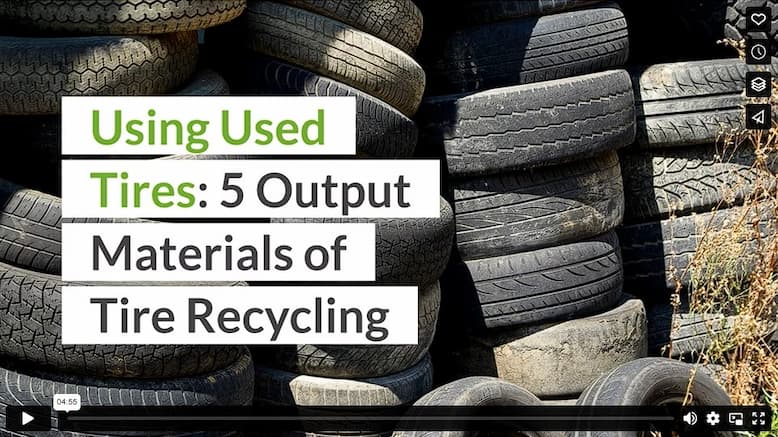Secondary recycling occurs when a product is broken down and repurposed into products different from the original commodity. Tire shredding equipment in today’s recycling plants reduces tire rubber into multiple secondary recycled materials, separating the rubber, steel and fiber for transformation into many sellable goods. Tire recycling creates five common output materials.
1. Rubber Chips
Rubber chips are relatively large pieces of tire rubber produced by primary tire shredders. The majority of rubber chips are burnt as tire-derived fuel (TDF). Producing more energy than coal and less harmful emissions, TDF is used to create electricity, concrete and steel. Because fuel is in constant demand and rubber chips are the most accessible tire recycling material, over half of recycled tires become a component of TDF.
Secondary shredders reduce the size of larger rubber chips to create smaller ones repurposed as mulch for gardens. Rubber chip mulch is superior to wood mulch because it does not rot, attract termites or wash away.
2. Crumb Rubber
The smaller cousin of rubber chips, crumb rubber, is the raw material for athletic tracks, rubber mats and playground surfaces. Crumb rubber is graded depending on the size and purity. The less fiber and metal wire the crumb rubber contains, the higher the grade. Artificial turfs require a higher grade of crumb rubber than the rubber used in civil engineering projects. Crumb rubber is also repurposed in speed bumps and a vibration barrier to reduce noise pollution from railway lines.
Old tires are a breeding ground for mosquitos, which cause malaria in South America. Transformadora de Gomas is a tire recycling plant in Venezuela that produces large amounts of quality crumb rubber from waste tires. The company uses the ECO Granulator and other ECO Green equipment to process over 750 tires per hour. Transformadora de Gomas turns these harmful mosquito breeding grounds into useful crumb rubber for local playgrounds and roofing projects.
3. Rubber Powder
If a tire recycling line has an ECO Krumbustor, a type of cracker mill, they can reduce tires further into rubber powder. The Krumbustor grinds crumb rubber into grains of rubber no larger than 0.75 mm. During production, all of the impurities are removed, making rubber powder a versatile raw material. Rubber powder finds utility in asphalt, paint and molded products such as oil seals and caps. Because rubber powder is a secondary material, it is significantly cheaper to use than manufactured rubber. Shoes, hoses and brake pads can also incorporate rubber powder.
4. Textile Fiber
Added to the rubber to increase lifespan, approximately 10% of a tire is fiber. Because the textile fiber is not the primary component, tire recycling processes often remove the fiber and do not repurpose it. In recent years, entrepreneurs and scientists have found multiple purposes for this secondary material. Some companies repurpose the fiber in carpet and fiberglass products. One research project found that adding fiber increases the fire resistance of concrete.
5. Metal Wire
Steel wire increases the durability of car and truck tires. When a tire’s tread wears thin, the wire incorporated into the tire’s design begins to show, indicating the need to replace them. During the recycling process, a large plate magnet removes this steel from the tire rubber. The recycling plant may choose to clean and melt the steel, making it suitable for recasting into many metal products. However, because tire wire has a large surface area when it is extracted from the tire, appearing like metal hair, it rusts quickly and is often contaminated. These challenges, in combination with a highly volatile market for the end product, leads many tire recycling companies not to repurpose the extracted wire.
Why Aren’t Tires Recycled into New Tires?
New tires cannot be made from old ones because the rubber in tires is cross-linked with sulfur. This chemical process creates vulcanized rubber. More durable and elastic than simple rubber, vulcanized rubber makes tires more suitable for the pressures and abrasion of constant use on the road. Vulcanized rubber does not melt, which makes it difficult to recycle into new tires. Some manufacturers have found ways to chemically alter the rubber from recycled tires and incorporate it into new tires. However, the majority of the tire rubber in new tires is still made from crude oil.
Tires are made to be durable, which poses challenges for recycling processes. However, when you drop a worn-out tire at a gas station or recycling plant, its utility is far from spent. It may become a useful fuel for cement or paper production. It could end up in your kids’ favorite playground. Industrial companies might incorporate the raw materials into roads your new tires travel over or the hose in your backyard. The secondary recycling process of reducing and repurposing tires is an important way to reduce waste and stress on land and natural resources by providing fiber, steel and rubber materials.
Video





